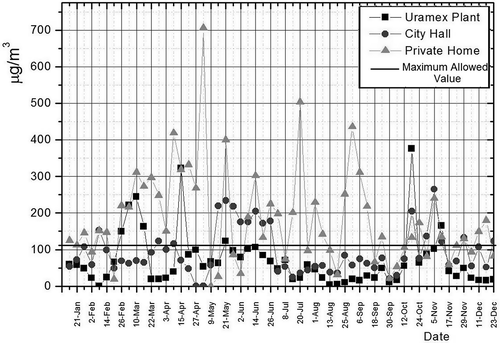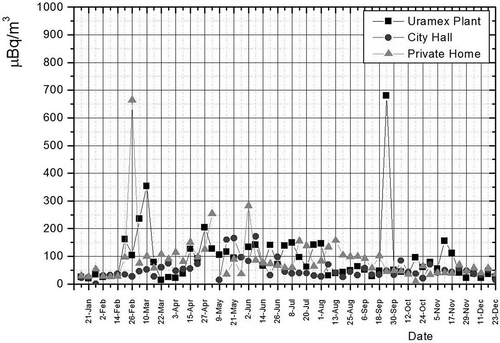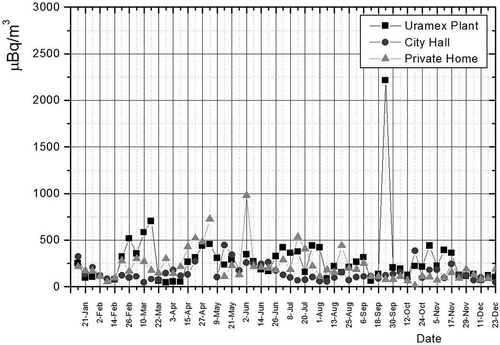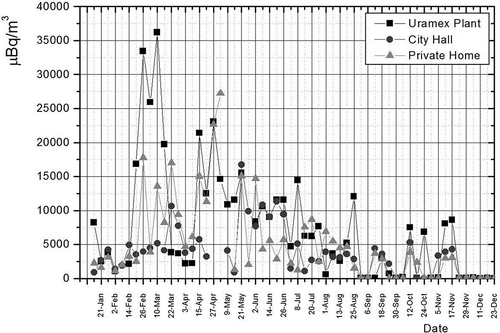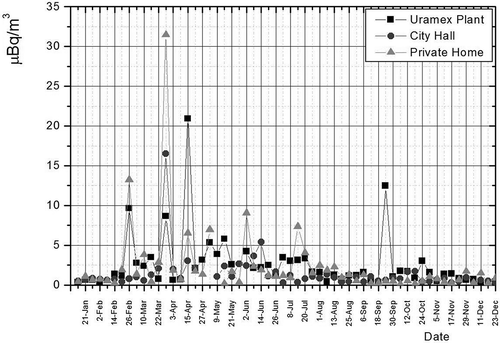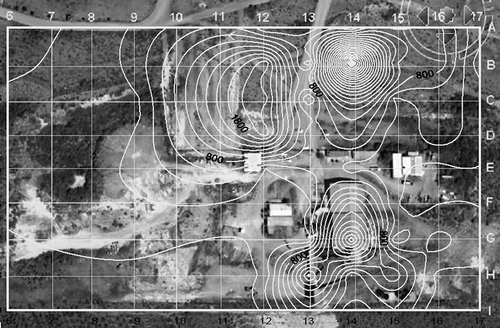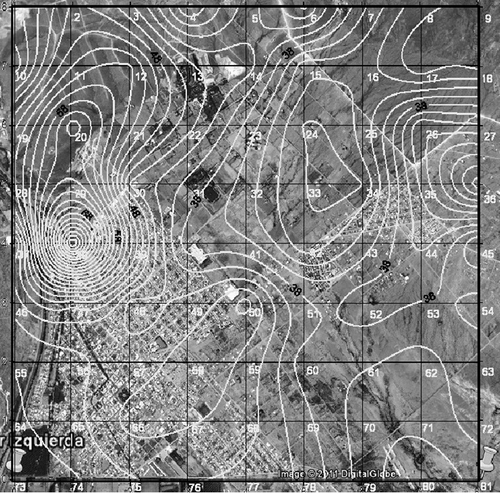Abstract
The city of Aldama, Chihuahua, Mexico is located 30 km NNE of Chihuahua city. Three high-volume collectors with PM10 heads were placed in specific locations in Aldama during the year 2011 to measure radioisotope concentrations in the air. The city area of 16 km2 was divided into 64 squares of 500 × 500 m. At the vertices of the grid, silt samples were taken between January and June 2011, before the rains began. The concentrations of natural, cosmogenic, and anthropogenic radioactive isotopes were calculated in both filters and silts samples. The isotopes selected for the measurement were 238U, 232Th, 7Be, 137Cs, and 40K. Measurements of PM10 and silts were performed during 2011, coinciding with the accident at Fukushima, Japan, on March 11. For this reason, we could see the 137Cs in PM10 increase between April and July; with the arrival of the rains, the 137Cs concentration began to decrease in the air. The concentration of PM10 measured by the equipment located at the Mexican Uranium plant (URAMEX, initials in Spanish) that was processing radioactive ores exceeded the standard values in February and March, when the air velocity increases. At City Hall, the concentration of PM10 surpassed the value of the standard between May and July. This increased concentration is likely due to increased automobile traffic because City Hall is located in the city center. At a private home, the concentration of PM10 surpassed the standard on several days during the year because the home is located on the outskirts of the city, where most of the streets are not paved. Due to the high concentrations of PM10, especially at the collection point located at the private home, it is necessary to start taking steps to mitigate their spread before they cause health problems in the younger population and in older adults.
Implications: The radioisotope content found in the PM10 confirms that the decision to place the Mexican Uranium plant (URAMEX, initials in Spanish) processing radioactive ores near the town of Aldama was not well thought out. Because the monitoring work was carried out in 2011 and coincided with the Fukushima accident, an increased concentration of 137Cs could be detected in the PM10. We made recommendations to the municipal authorities of the city to mitigate the concentration of particles in the air.
Introduction
The world population is constantly exposed to radiation through natural and anthropogenic sources and through processes that involve the use of radiation and radioactive substances. These include mining, energy production through combustion of coal, medicine, environmental pollution by radioactive waste resulting from nuclear weapons testing, and nuclear accidents on a large scale. These remain a comprehensive source of human exposure (United Nations Scientific Committee on the Effect of Atomic Radiation [UNSCEAR], 2008).
The exploration of radioactive minerals in Mexico began in 1955 and was under the charge of a federal government agency, the National Nuclear Energy Commission, until 1972. In 1979, this agency was divided into the National Institute for Nuclear Research (ININ, initials in Spanish), the National Commission for Nuclear Safety and Safeguards (CNSNS, initials in Spanish), and Mexican Uranium (URAMEX, initials in Spanish), which was created to develop the mining stage of the nuclear cycle (exploration, exploitation and processing of radioactive minerals) (Perea Saenz, Citation1979). URAMEX was closed in accordance with the law in 1987 as a result of political and labor conflict; its functions of exploitation and profit were delegated to the Council of Mineral Resources (CRM, initials in Spanish), now known as the Mexican Geological Service (SGM, initials in Spanish).
The first exploration of radioactive minerals in Mexico focused on calcareous rocks. Molybdenum ore was first extracted in the Sierra Gomez, Chihuahua, and the Escrow Mining Promotion (FIFOMI, initials in Spanish) tested a pilot plant a few hundred meters from the city of Aldama, Chihuahua. The uranium deposits located in the Peña Blanca Range, a municipality of Aldama, Chihuahua, are 85 km north of Chihuahua City. This range consists of a sequence of limestone, shale, and sandstone of the Paleozoic era and Cretaceous limestone, overlain by tertiary felsic volcanic rocks.
The objective of this work is estimate the activities of 238U and 232Th deposited during the time the plant of URAMEX was in operation (1979–1987) both in PM10 in air and in silts on the soil of the city. These concentrations will also serve as boundary and initial conditions for the CALPUFF program, with which dispersion and deposition of radioactive particles produced during the extraction of uranium can be estimated (Rood et al., Citation2008). Other isotopes of cosmogenic, anthropogenic, and natural origin, such as 7Be, 137Cs, and 40K, respectively, were also included in the analysis.
Monitoring of PM10 in air for 1 year and determining the concentration of radionuclides in PM10 and in silts in the soil had not ever been done in the city of Aldama, so this work will help to determine the concentration on PM10 in the air and the activity of the radionuclides in both.
Materials and Methods
Three PM10 Greasegy Andersen/GMW model 1200 high-volume air samplers (RFPS-1287-063: U.S. Environmental Protection Agency [EPA], 2001) were placed in specific locations in the city of Aldama to measure isotope concentrations in the air. The collectors were placed in the upper part of the URAMEX plant, on the roof of City Hall, and on the roof of a private home, to form an almost isosceles triangle and thus cover the entire city; see . As seen in , the city area of 16 km2 was divided into 64 squares of side 500 m. In the vertices of the grid formed, silt samples were taken between January and June 2011, before the rains that began in late June.
Figure 1. Location of PM10 collectors in URAMEX (P1), City Hall (P2), and the private home (P3) and silts samples (numbers) in the city of Aldama.
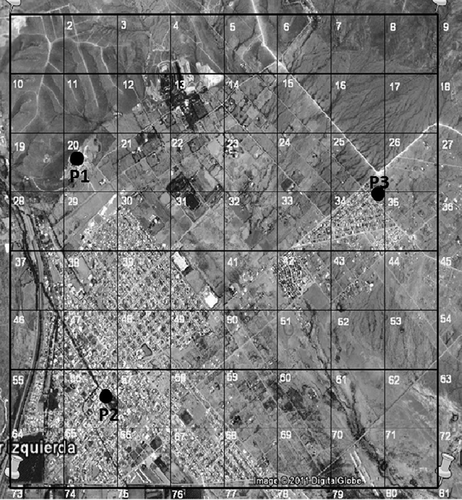
Whatman glass-fiber filters (8 × 10 inches; GE Healthcare, Citation2015) were conditioned, placed in a controlled environment for 24 hr at 25°C and 60% moisture, and weighed in a microanalytical balance before and after the collection. The aerosol collection was performed following the timetable proposed by the EPA in 2011 (every 6 days) and the Mexican Official Standard NOM-035-ECOL-1993 (Secretaria de Economía [SE], 1993a). The mud samples were collected and sieved according to ASTM method C136 and EPA methods (C136-06 STM, 2012; Method IO-2.2, EPA, 1999; EPA, 1993b, AP-42 Appendix C.2; EPA, 1993a, AP-42 Appendix C.1), with grains of up to 75 µm, and deposited in 5 × 5 cm polyethylene containers.
The concentrations of uranium and thorium and the anthropogenic, natural and cosmogenic isotopes were calculated in both filters and silts. The PM10 concentration was determined following the method described in the Mexican Official Standard NOM-035-ECOL-1993 (SE, Citation1993a), which specifies that the difference in weight of the filter before and after the collection corresponds to the concentration of PM10 in the air. Concentrations of the particles collected on the filters were determined in micrograms per cubic meter (µg/m3) and were converted to microbecquerels per cubic meter (µBq/m3). For the case of silts, the concentration was in becquerels per kilogram (Bq/kg), based on the weight of the collected sample.
Both filters and silts samples were measured for 24 hr in a CANBERRA coaxial HPGe gamma spectrometer with an active volume of 60 cm3. The detector is basically a cylinder of germanium with an n-type contact on the outer surface, and a p-type contact on the surface of on an axial well. The detectors have 20of relative efficiency with 1.33 MeV of 60Co. All spectra were processed using the Spectrum Analyzer Code (SA-1997: Perdomo et al., Citation1997). The spectra obtained from measurements of filters and polyethylene cylindrical containers must be corrected for efficiency. The filters were folded into four parts, so that the geometry was completely atypical, and Monte Carlo modeling, using the DOSRZ program (as variant of EGS4: EGS4, Citation2007), was required. For this method 10 million events were used, thus minimizing the error introduced. Using a calibrated point source of 125Sb-154Eu-155Eu (SRM 4275C-129 of the National Institute of Standards [NIST]), the double logarithmic curve of photopeak efficiency versus energy of gamma rays was obtained. By means of DOSRZ, geometric rates of the solid angle were calculated to correct the efficiency values of the geometry measurement in filters and silts with cylindrical vessels. The corrected value of efficiency referred is obtained by multiplying the average of the punctual photopeak efficiency and the solid angle of geometries for each detected energy.
We selected those isotopes due to the Natural Radioactive Series 238U and 232Th that were present in the measured spectra. To achieve the radioactive secular equilibrium, both samples were collected and deposited onto filters for PM10 and polyethylene containers for silts. The samples were thereafter stored for at least 1 month.
The values of the specific activities (Bq/kg) from each of the 81 vertices sampled were processed using Surfer V8 2002 (SURFER, 2002). Using the values of the isotopic concentration isopleths, we can understand how the isotope bearing particles were dispersed during plant operation and for the period until 1987.
Meteorological data generated by the station located in the city of Aldama in 2011 were obtained to know the speed and direction of wind and environmental conditions in the days when the PM10 measurements were performed and silts samples were collected. This meteorological station is administered by Central Board of Water and Sanitation of the State of Chihuahua.
Results and Discussion
PM10 concentration in filters
PM10 concentrations in the filters from the three points and the comparison with the standard are shown in . This figure also shows that the filters with higher particle concentration were measured in the URAMEX plant on October 18 with a value of 376 μg/m3, at City Hall on November 5 with 265 μg/m3, and at the private home on May 3 with 706 μg/m3. The concentration of PM10 collected in filters in 2011 was compared with the maximum permissible value according to Mexican Official Standard NOM-025-SSA1-1993 (SE, Citation1993b), which is 120 µg/m3. It was found that the maximum allowed value is exceeded in the URAMEX plant only in the months of February, March, April, October, and November. This is likely the result of airborne particles picked up when the wind speed is high, because the plant is located on the outskirts of the city and near a hill and where the streets are unpaved so motor traffic is reduced. For filters located at City Hall, values that exceeded the standard occurred in the same months as the URAMEX plant, as well as in the months of May to July. This is perhaps due to increased motor vehicle traffic, as it is located downtown where the streets are paved. At the private home location, more than half of the filters had concentrations that exceeded the value of the standard. This site is located on the outskirts of the city and near the bank of materials from a company that manufactures ceramic floors; the streets are also unpaved. Besides the sampled points being located in the center and on the outskirts of the city, these are at different heights, which could be causing very local environmental conditions and therefore be affecting the concentration of PM10.
Concentration of radioisotopes in filters and silts
In we can see that the highest concentration values of 232Th was on February 26 at the private home with 664 μBq/m3 with strong southeast wind components that exceeded the threshold wind drag of 10 m/sec for PM10 particles (Rodríguez, Citation2009), reaching 50 m/sec from the direction of the plant. In the URAMEX plant the maximum concentrations were presented on March 10 and September 24 with 353 μBq/m3 and 680 μBq/m3, respectively. The winds also exceeded the threshold of 10 m/sec, but southwest.
The highest 238U value was found at the URAMEX plant with 2214 μBq/m3 on September 24. Like the 232Th, wind speeds exceed the threshold, with gusts up to 23 m/sec. It should be clarified that the high-volume collector was placed near the hoppers where raw materials extracted in Peña Blanca mine were discharged. In the private home, the maximum concentration detected was on June 2 with a value of 979 μBq/m3 and with gusts up to 63 m/sec primarily from the direction where the URAMEX plant is located, as shown in .
The highest 7Be value found at the URAMEX plant was 36172 μBq/m3 between February 26 and March 10 (), coinciding with the time of year when the wind speed is higher and higher concentrations of particles were measured. The high values of the concentration of 7Be are due to the latitude where the measurement is performed and also the height of the City of Aldama (about 1300 m). Also, this is a cosmogenic isotope and is constantly occurring in the atmosphere due to reactions of nitrogen with cosmic rays.
The cause of the high value of the concentrations of 7Be is because it depends on the concentration of airborne particles, which are high between February and May; addition is also determined because in these months the weather is winter and spring, when there are larger numbers of cold fronts that cause deformation and even discontinuity in the tropopause, which permits a greater amount of this isotope from the upper layers of the atmosphere (Ioannidou and Papastfanou, Citation2005).
137Cs is a completely anthropogenic isotope found globally due to nuclear explosions at Hiroshima and Nagasaki. Since 1945, the amounts of this isotope are mainly attributed to a phenomenon known as fallout. The concentrations of this isotope in the air were critical during the 1960s as a result of nuclear tests by the United States, Russia, France, and China. This can be seen in . This graph is obtained from an empirical equation of the extrapolated values of 137Cs concentrations from 7Be as a tracer in regions of relatively latitudes near to 30° north (Hernández et al., Citation2003; Escudero, Citation2007).
Normally, 137Cs is found in higher or lower concentrations both in the air and on the ground, respectively, because once it is captured from its original source by the general circulation of the atmosphere, it spreads across the surface of the earth, and returns to the air by wind drag. Because 137Cs has a half-life of 30 years, it may be present in any of the samples of PM10 or silts. The latest data showed that the concentration of 137Cs before 2011 was due to the accident at Chernobyl, Ukraine, whose activity in Chihuahua was 2.3 mBq/m3 in air, as can also be observed in .
Measurements of PM10 and silts were performed during the year 2011, coinciding with the accident in Fukushima, Japan, on March 11. An increase in the concentration of 137Cs in air as a result of this accident was observed in the three points (), where the maximum value was on March 28, measuring 31 µBq/m3 at the private home.
Other high values of the concentration of 137Cs could be observed on February 26 caused by resuspension of particles with contents only due to the Chernobyl accident, whereas in the days of April 15 and September 24 high values are again caused by resuspension of particles, but including 137Cs accumulated by the accident of Fukushima more than from Chernobyl.
In , we can see that 40K behaves very similarly to 232Th and 238U, implying that these radioisotopes are geologically related.
Although several gamma lines were measured, we only show the results of uranium isotope for the goal of modeling the emissions in the years when the plant was active and for the surprising results of differences of 137Cs in air due to the Fukushima accident.
The uranium concentrations at the plant indicate that there was a shift in the material, and therefore of radioactive contamination, to the northwest of the plant. Research indicates that once the plant was closed the tanks or storage hoppers were cleaned, and this was where the process of separation of ore minerals was performed. This cleaning was performed with pressure water hoses, so that all contaminated material dissolved and ran toward low-lying areas of the plant, resulting in stagnation; later, the wind spread the radioactive material throughout the city. shows the distribution of the specific activity of uranium in the areas surrounding the plant. The specific activity values reach 4800 Bq/kg at 100 m north of the plant entrance. The plant is only a few hundred meters from the city. The terrain slopes toward the direction of the Chuviscar River. In the URAMEX plant itself were detected two foci, one with a concentration of 2600 Bq/kg and another with 1800 Bq/kg, in the area where the raw material from the Peña Blanca ore mine was discharged.
The overall analysis for the entire city of Aldama shows that higher concentrations of uranium eventually flowed into the Chuviscar River at the entrance to the city, but the specific activity decreases rapidly from thousands to dozens of Becquerels per kilogram. This has been proven in previous works (Colmenero et al., Citation2004). As shown in , the concentration can reach nearly 100 Bq/kg. In the upper right of the figure, some increases can be seen along the road leading to the mining areas.
shows a surface plot of the specific activity of 238U made by SURFER V8. The meteorological data recorded at the meteorological station of the Central Board of Water and Sanitation indicate that the annual mean wind is from the southeast. This coincides with the great mass of pollution that has been moving toward the northwest, the site of the city’s greatest population density.
Summary
Due to the high concentrations of airborne particles, especially at the collection point located at the private home, it is time to start taking steps to mitigate their spread before they cause health problems in the younger population and in older adults. Therefore, it was recommended to municipal authorities that the streets be paved. It would also be important to begin to implement programs to reduce pollution from motor vehicle traffic.
Concentrations of radioactive isotopes were found above the usual in silts and PM10 particles in the study area. Concentrations of PM10 exceeded the maximum allowed by the standard in the months of highest wind speed. Other causes of high concentrations of PM10 are the lack of paved streets and traffic of motor vehicles.
High concentrations of 238U and 232Th isotopes, due to the accumulation of radioactive material used in the time the URAMEX plant was in operation, were detected both in silts and in particles.
The highest concentrations of uranium in silts in the area of the URAMEX plant were detected displaced approximately 100 m north of the plant. The main focus of radioactive contamination has a value of 4800 Bq/kg, although there was another area found further west with concentrations of about 2000 Bq/kg. In the area where the raw material of the Peña Blanca ore was discharged two foci were found, one with a concentration of 2600 Bq/kg and another of 1800 Bq/kg.
The general analysis for the entire city of Aldama shows that the highest concentrations of uranium eventually flow into the Chuviscar River, at the entrance to the city, but the specific activity decreases rapidly from thousands to tens of becquerels per kilogram.
Another interesting result was able to assess and account the increased concentration of 137Cs at 15 days after the Fukushima accident.
Additional information
Notes on contributors
Michel Y. Montelongo
Michel Y. Montelongo is a doctoral student in the Department of Materials at the Advanced Materials Research Center (CIMAV), Chih, Chihuahua, Mexico, and is a professor at the Autonomous University of Chihuahua (UACH).
Eduardo F. Herrera
Eduardo F. Herrera is currently the chief of the Department of Renewable Energy and Environmental Protection at the Advanced Materials Research Center (CIMAV), Chih, Chihuahua, Mexico, and is a professor of the Autonomous University of Chihuahua (UACH).
Elias Ramirez
Elias Ramirez, Jorge I. Carrillo, Alfredo Campos, and Ramón Gomez are currently technicians and Maria E. Montero is currently a researcher in the Department of Renewable Energy and Environmental Protection at the Advanced Materials Research Center (CIMAV), Chih, Chihuahua, Mexico.
Jorge I. Carrillo
Elias Ramirez, Jorge I. Carrillo, Alfredo Campos, and Ramón Gomez are currently technicians and Maria E. Montero is currently a researcher in the Department of Renewable Energy and Environmental Protection at the Advanced Materials Research Center (CIMAV), Chih, Chihuahua, Mexico.
Alfredo Campos
Elias Ramirez, Jorge I. Carrillo, Alfredo Campos, and Ramón Gomez are currently technicians and Maria E. Montero is currently a researcher in the Department of Renewable Energy and Environmental Protection at the Advanced Materials Research Center (CIMAV), Chih, Chihuahua, Mexico.
Ramón Gomez
Elias Ramirez, Jorge I. Carrillo, Alfredo Campos, and Ramón Gomez are currently technicians and Maria E. Montero is currently a researcher in the Department of Renewable Energy and Environmental Protection at the Advanced Materials Research Center (CIMAV), Chih, Chihuahua, Mexico.
Maria E. Montero
Elias Ramirez, Jorge I. Carrillo, Alfredo Campos, and Ramón Gomez are currently technicians and Maria E. Montero is currently a researcher in the Department of Renewable Energy and Environmental Protection at the Advanced Materials Research Center (CIMAV), Chih, Chihuahua, Mexico.
Luis M. Rodriguez
Luis M. Rodriguez is currently a professor at the Technical Institute of Hidalgo del Parral, Chihuahua, Mexico.
References
- ASTM. C136-06 Standard Test Method for Sieve Analysis of Fine and Coarse Aggregates. 2012.
- Colmenero L., M.E. Montero, L. Villalba, M. Renterıa, E. Torres, M. Garcıa, R. Garcıa, F. Mireles, E.F. Herrera, and A. Sanchez. 2004. Uranium-238 and thorium-232 series concentrations in soil, radon-222 indoor and drinking water concentrations and dose assessment in the city of Aldama, Chihuahua, Mexico. J. Environ. Radioactivity 77:205–219. doi:10.1016/j.jenvrad.2004.03.008
- EGS4 Source Code Availability and Distribution. 2007. http://rcwww.kek.jp/research/egs/egs4_source.html
- Escudero, Y. 2007. Obtención de las concentraciones históricas de 137Cs en la ciudad de Chihuahua utilizando el 7Be como trazador. PhD dissertation, CIMAV, Chihuahua, Mexico.
- GE Healthcare. 2015. Leadership in separation technology for the life sciences. http://www.gelifesciences.com/webapp/wcs/stores/servlet/catalog/en/GELifeSciences-MX/brands/whatman
- Hernández, A., H. Cartas, M. Díaz, and A. Muñoz. 2003. Reconstruction of 137Cs signal in Cuba using 7Be as tracer of vertical transport processes in the atmosphere. J. Environ. Radioactivity 75(2004):133–142.
- Ioannidou, A., and C. Papastfanou. 2005. Precipitation scavenging of 7Be and 137Cs radionuclides in air. J. Environ. Radioactivity 85(2006):121–136. doi:10.1016/j.jenvrad.2005.06.005
- Perdomo, J., and C. Trápaga. 1997. Programa Spectrum Analyzer. Tesis de Licenciatura. ISCTN, Habana, Cuba.
- Perea Saenz, A. 1979. Explotación del yacimiento uranífero el “Nopal 3” Sierra Peña Blanca Mpio. de Villa Aldama, Estado de Chihuahua. Tesis, Autonomous University of Chihuahua, Chichahua, Mexico.
- Rodríguez L. 2009. Simulación de la Dispersión de Radionúclidos en el Valle de Chihuahua. PhD dissertation, Autonomous University of Chihuahua, Chichahua, Mexico.
- Rood, A., P.G. Voilleque, S.K. Rope, H.A. Grogan, and J.E. Till. 2008. Reconstruction of atmospheric concentrations and deposition of uranium and decay products released from the former uranium mill at Uravan, Colorado. J. Environ. Radioactivity 99:1258–1278. doi:10.1016/j.jenvrad.2008.03.009
- Secretaria de Economía (SE). 1993a. NOM-035-ECOL-1993 que Establece los métodos de medición para determinar la concentración de partículas suspendidas totales en el aire ambiente y el procedimiento para la calibración de los equipos de medición. http://www.semarnat.gob.mx/leyes-y-normas/nom-concentraciones
- Secretaria de Economía (SE). 1993b. NOM-025-SSA1-1993 Criterios para evaluar el valor límite permisible para la concentración de material particulado. Valor límite permisible para la concentración de partículas suspendidas totales PST, partículas menores a 10 micrómetros PM10 y partículas menores de 2.5 micrómetros PM2.5 de la calidad del aire ambiente. Criterios para evaluar la calidad del aire. http://www.salud.gob.mx/unidades/cdi/nom/025ssa13.html
- SURFER Version 8. 2002. Surface mapping system. Golden, CO: Golden Software, Inc.
- United Nations Scientific Committee on the Effect of Atomic Radiation. 2008. Report of the United Nations Scientific Committee on the Effect of Atomic Radiation to the General Assembly, Exposure from Natural Radiation Sources. New York, NY: UNSCEAR.
- U.S. Environmental Protection Agency. 1993a. Procedures for laboratory analysis of surface/bulk dust loading samples. AP-42, Appendix C.2.E.U. http://www.epa.gov/ttnchie1/ap42/appendix/app-c2.pdf
- U.S. Environmental Protection Agency. 1993b. Procedures for sampling surface/bulk dust loading. AP-42, Appendix C.1. E.U. http://www.epa.gov/ttnchie1/ap42/appendix/app-c1.pdf
- U.S. Environmental Protection Agency. 1999. Method IO-2.2: Sampling of ambient air for PM10 using an Andersen dichotomous sampler. Compendium of Methods for the Determination of Inorganic Compounds in Ambient Air. Office of Research and Development. U.S. EPA. http://www.epa.gov/ttnamti1/files/ambient/inorganic/iocompen.pdf
- U.S. Environmental Protection Agency. 2001. RFPS-1287-063 Graseby Andersen/GMW model 1200 high-volume air sampler. http://www.epa.gov/ttnamti1/files/ambient/criteria/reference-equivalent-methods-list.pdf

